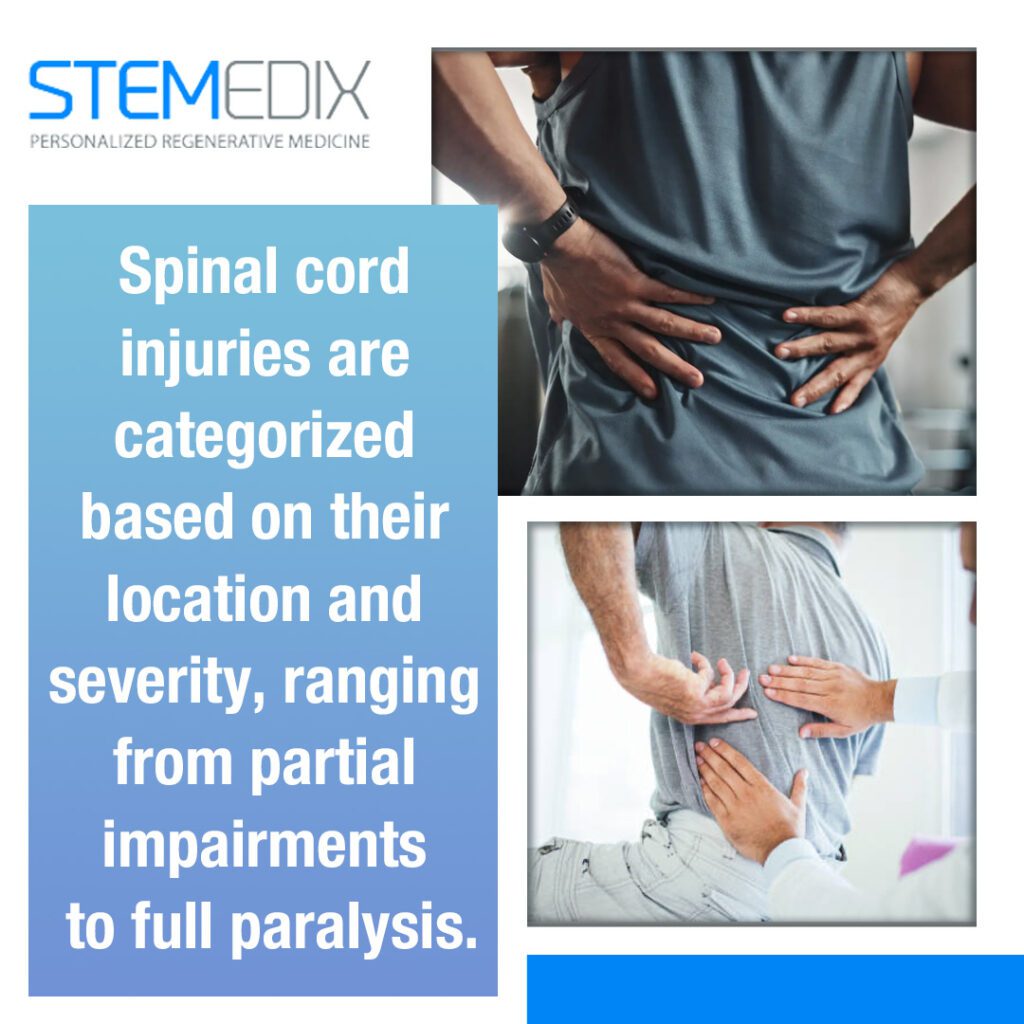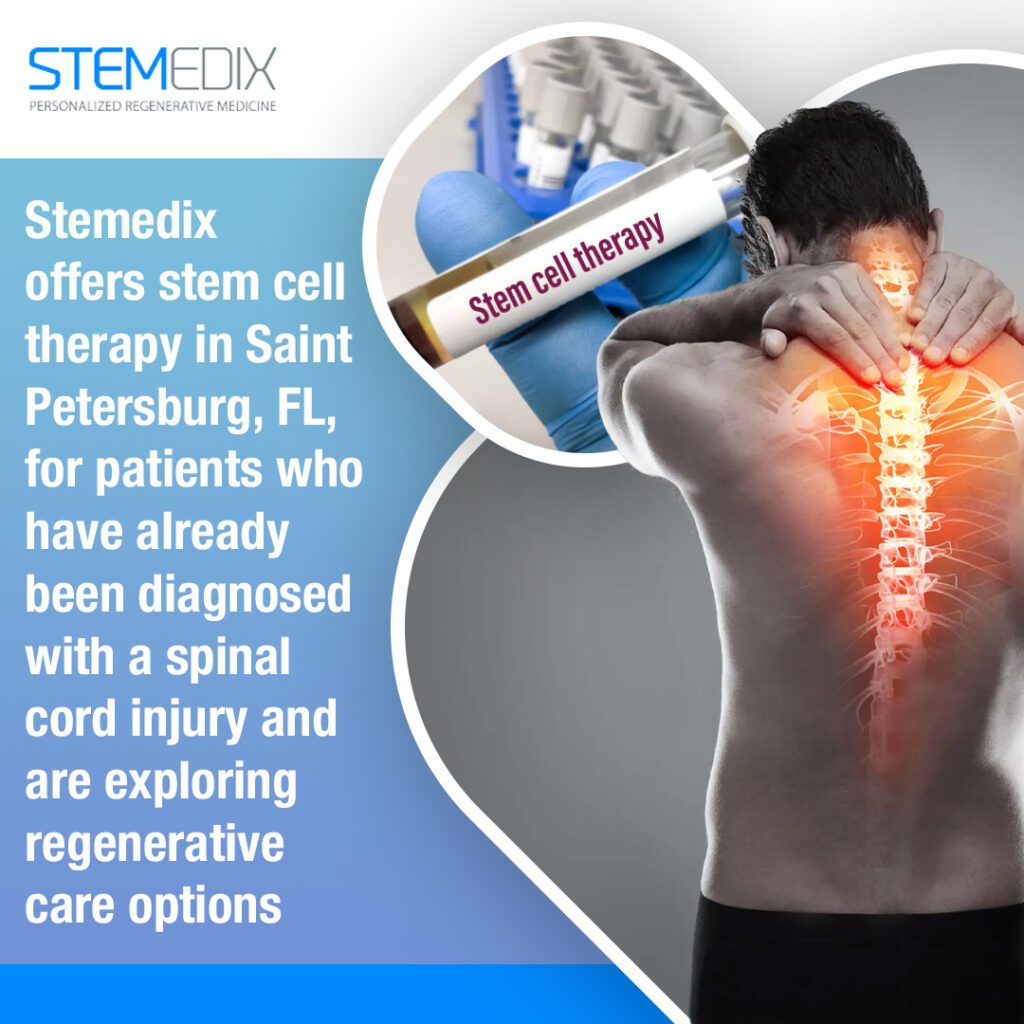Spinal cord injuries can drastically alter your quality of life, affecting everything from mobility to essential bodily functions. At Stemedix, we understand how overwhelming it can be to face such a diagnosis and how important it is to explore every option available for symptom management and potential improvement. That’s where stem cell therapy comes into the conversation. It offers a promising avenue for individuals seeking personalized, science-aware approaches to healing.
Our team provides stem cell treatments for patients who have already been diagnosed with spinal cord injuries and are looking for support beyond conventional routes. At our facility offering stem cell therapy in Saint Petersburg, FL, your care is built around your unique medical records, goals, and recovery journey. In this article, we’ll look at the most common causes of spinal cord injuries and how stem cell therapy may play a supportive role.

Understanding Spinal Cord Injury
Spinal cord injuries can affect nearly every aspect of how you move, feel, and interact with the world around you. By understanding how the spinal cord works and how these injuries are classified, you’re better prepared to evaluate care options that support your recovery goals.
How the Spinal Cord Functions
The spinal cord transmits signals between the brain and the body to control movement and sensation. This long, cylindrical structure is made up of nerve tissue and extends from the base of your brain down through your lower back, protected by the vertebrae. It acts as a highway for electrical impulses that direct voluntary movements, like walking or gripping, and involuntary functions, including digestion and heart rate. When you decide to lift your arm, the command starts in your brain, travels down the spinal cord, and reaches the appropriate muscle groups. At the same time, sensory information from your skin and joints travels back through the cord to the brain, helping you recognize pain, temperature, or balance.
Any injury to this pathway can disrupt those connections. Depending on where the damage occurs and how extensive it is, you may experience reduced mobility, numbness, spasticity, or even complete loss of movement and sensation.
Classification of Spinal Cord Injuries
Spinal cord injuries are classified as complete or incomplete and are identified by their location on the spine. A complete injury means that all communication between the brain and the body below the injured segment has been lost. This often results in full paralysis in those areas. An incomplete injury, on the other hand, leaves some pathways intact. You may retain partial movement, feeling, or control, depending on the extent of nerve preservation.
The level of the injury also matters. The spinal cord is divided into four regions:
- Cervical (C1–C8): Located in the neck. Injuries here often impact the arms, hands, and diaphragm, and may require ventilatory support.
- Thoracic (T1–T12): Mid-back area. Damage here typically affects the trunk and legs.
- Lumbar (L1–L5): Lower back. Injuries may affect leg movement, bladder, and bowel control.
- Sacral (S1–S5): Base of the spine. These injuries generally influence the hips, groin, and lower limbs.
Even small differences in injury level can change the long-term outlook. For example, someone with an incomplete cervical injury may retain hand movement, while another with a complete thoracic injury may lose all function below the chest.
Leading Causes of Spinal Cord Injury
Spinal cord injuries result from a variety of causes, some sudden and traumatic, others progressive and medical. It’s important to understand how these injuries occur so you can better recognize their impact and consider supportive approaches to care, such as stem cell therapy.
Traumatic Accidents
Motor Vehicle Collisions
If you’ve been involved in a car crash, you know how fast everything changes in an instant. Motor vehicle collisions remain one of the most frequent sources of spinal cord trauma. The sudden force during impact can crush vertebrae, shift spinal discs, or directly damage the spinal cord. Even with seat belts and airbags, the rapid deceleration from a collision can stretch or compress delicate nerve tissues, leading to partial or complete loss of movement or sensation below the injury site.
Falls
Falls are another leading contributor, especially among older adults. These accidents often occur in everyday settings—on stairs, ladders, or slick flooring. When your body hits the ground with force or lands in an awkward position, the spine can absorb a level of impact it wasn’t designed to handle. This can lead to vertebral fractures or compression of the spinal cord. Even a seemingly minor fall can result in lasting effects if the spine is involved. That’s why it’s essential to treat any fall-related injury seriously and review medical imaging before considering regenerative options like stem cell therapy.
Sports and Recreational Injuries
You don’t have to be a professional athlete to experience a sports-related spinal injury. Activities like football, gymnastics, wrestling, diving, and skiing all carry risks due to the high speeds, physical contact, or the possibility of falling. While protective gear helps reduce exposure, it doesn’t eliminate it.
Sports injuries are responsible for about 9% of spinal cord injuries each year. These often affect younger adults and teenagers, whose active lifestyles and high-impact participation increase vulnerability. Common outcomes include damage to the cervical spine, which can lead to serious complications depending on the force and angle of the incident.
Acts of Violence
Intentional harm also plays a role in spinal trauma. Gunshot wounds, stabbings, and blunt force from assault can damage the spinal cord directly. The spinal cord is extremely sensitive to penetration and bruising. A bullet or knife that comes into contact with the spine can immediately destroy nerve tissue or cause bleeding and swelling that leads to delayed injury. In many cases, these injuries are permanent and may impact mobility, bladder control, or respiratory function.
Non-Traumatic Factors
While traumatic events receive more attention, non-traumatic spinal cord injuries are just as serious and often progress over time. These injuries usually develop due to health conditions that affect the spine or nervous system gradually.
Tumors
Spinal tumors, whether benign or malignant, can press against the spinal cord as they grow. These growths may begin within the spinal cord or develop in nearby tissue, placing pressure on surrounding structures. This compression disrupts nerve signals and may produce pain, numbness, or muscle weakness.
Some patients don’t recognize these symptoms as spinal-related until imaging reveals the underlying cause. Because of this, early diagnosis and proactive management are key before structural damage becomes advanced.
Degenerative Conditions
As you age, changes in your joints and bones can affect the integrity of your spine. Conditions like osteoarthritis or spinal stenosis gradually narrow the space inside the spinal canal. This narrowing puts pressure on the spinal cord or nearby nerve roots, interfering with motor function and causing chronic discomfort.
These issues often begin subtly, with minor stiffness or discomfort, but can progress over time to impair mobility or coordination. If you’ve been diagnosed with a degenerative spine condition, maintaining a record of your symptoms and medical imaging can support the development of future care strategies, including possible stem cell therapy.
Infections and Inflammation
Certain infections, such as meningitis or abscesses in the spine, can lead to serious inflammation. Autoimmune responses from diseases like multiple sclerosis or transverse myelitis can also result in tissue damage within the spinal cord. In both cases, the protective barriers of the spine may become compromised, making the nerves more susceptible to injury.
While these conditions may not involve direct trauma, the impact on neurological function is often the same. Swelling, lesions, or scar tissue can alter how your nerves transmit signals to and from the brain, affecting everything from sensation to muscle control.
Each cause listed above brings its challenges and considerations, but all of them highlight one truth: spinal cord injury is deeply personal and varies case by case. At Stemedix, we work with individuals who have already received a diagnosis and provide stem cell therapy that aligns with their documented condition. Our goal is to support your journey with information, care options, and personalized stem cell treatments delivered with clinical integrity. If you’re seeking stem cell therapy in Saint Petersburg, FL, we’re here to guide you through the next steps with clarity and respect for your goals.
What Are Stem Cells?
Stem cells are undifferentiated cells capable of transforming into specialized cell types. These cells serve as the body’s repair system. They are found in various tissues, including bone marrow, fat, and umbilical cord blood. What makes them different from other cells is their ability to develop into different types of cells, such as neurons, muscle cells, or bone cells, depending on the signals they receive in the body.
They contribute to tissue repair by replacing damaged cells and releasing growth factors that aid healing. Once introduced into an area of injury, stem cells can adapt to the local environment. They don’t just settle in; they actively interact with damaged tissue. By secreting growth factors and cytokines, proteins that regulate immune responses, they help guide nearby cells to function better or begin repair. This ability to modulate inflammation and stimulate native repair processes is part of what makes them a candidate for ongoing investigation in the treatment of neurological conditions.
Stem Cell Therapy for Spinal Cord Injury
Stem cell therapy aims to repair damaged spinal tissue and support neurological recovery. In patients with spinal cord injuries, the protective layers around nerve cells are often damaged. That leads to a loss of signal transmission between the brain and the body. Through stem cell therapy, we introduce regenerative cells into areas where damage has interrupted this communication. These cells may support structural recovery by fostering a more favorable environment for surviving neurons.
These cells promote regeneration by encouraging nerve growth and reducing inflammation within injured areas. Stem cell treatments represent an emerging option in managing spinal cord injury symptoms. Stem cell activity goes beyond cell replacement. They can create biochemical conditions that help reduce scarring and preserve existing nerve function. In preclinical studies, stem cells have shown the capacity to stimulate axonal regrowth, the process by which nerve fibers try to reconnect after injury.
As of now, these treatments are classified as experimental. Data collected from patient registries, published research, and institutional studies point toward improved functional outcomes for some individuals, but results vary by injury type, severity, and timing. Stem cell therapy is being explored as a possible addition to traditional management.
At Stemedix, we offer stem cell treatments under physician guidance for patients who have already received a confirmed spinal cord injury diagnosis. Our approach is structured around the medical records you provide and focuses on safe, evidence-aware care planning.

The Stemedix Approach in Saint Petersburg, FL
Stem cell therapy is a personal journey, one that requires clarity, care, and a focused approach. At Stemedix, we’ve designed our model to support you every step of the way, beginning with a clear review process and extending through to treatment planning and logistical support.
Patient-Centered Care Model
Stemedix treats patients with previously diagnosed spinal cord injuries. We request existing medical records and imaging from patients to guide personalized stem cell therapy in Saint Petersburg, FL. We only accept patients who have already received a formal diagnosis from their licensed healthcare provider. You don’t need to repeat expensive scans or go through unnecessary imaging. We can use your existing MRI reports, lab results, and physician documentation if they are recent. If those records are outdated, we may request updated tests. This approach helps you move forward faster while avoiding unnecessary costs and disruptions.
Our goal is to help you explore stem cell treatments in a way that is based on real-world clinical data and your existing medical background, not on generalized assumptions. If your records indicate the presence of spinal cord injury, our team can determine whether there is a reason to consider regenerative therapy based on your condition stage, past treatments, and current challenges.
Customized Therapy Planning
Board-certified physicians review each case to develop individualized stem cell treatment strategies. Patient safety and potential benefit are evaluated before therapy is approved. This isn’t an automated or generic process. Your submitted records are thoroughly examined to determine whether your case fits within the treatment criteria for stem cell therapy. If there is any uncertainty, further clarification is requested before proceeding.
Before anyone is approved for therapy, we evaluate two things: Is there potential for benefit based on your type of injury, and is the treatment safe for your current medical profile? Many of these injuries fall into categories that have been studied in early-phase regenerative medicine research. Our treatment strategies reflect this evolving clinical insight, but we never rush decisions. We prioritize clarity and safety throughout the process.
Supportive Services Offered
Stemedix assists with travel arrangements, accommodations, wheelchair transportation, and caregiving needs. These services support patients throughout their stem cell therapy journey in Saint Petersburg, FL.
We recognize that traveling for stem cell therapy in Saint Petersburg, FL, can feel like a major effort, especially if you have mobility restrictions or require daily support. That’s why we offer travel assistance to help you plan every detail. From booking accessible hotel accommodations to coordinating transportation for wheelchairs and specialized medical equipment, we take care of the logistics so you and your caregivers can focus on what matters.
We also connect you with trusted local caregivers if needed during your stay. Whether you’re traveling from another part of Florida or across the country, you won’t have to navigate this process alone.
At Stemedix, our role is to support you with structured, safe, and medically reviewed stem cell treatments that reflect your goals and clinical history, not just the condition you’ve been diagnosed with.
Is Stem Cell Therapy the Right Path for You?
Candidate Review and Next Steps
Patients must submit prior diagnoses and medical documentation for evaluation. Our physicians focus on safety and suitability when reviewing candidates for stem cell treatments.
Before we consider any therapy, you’ll need to provide documentation confirming a spinal cord injury diagnosis. This includes medical records, imaging, and physician notes. Our board-certified regenerative medicine team reviews each case individually, evaluating your history and current status to determine if stem cell treatments may be appropriate.
Schedule a Consultation with Stemedix
Prospective patients can contact Stemedix to request information or speak with a Care Coordinator. This process begins a guided review of stem cell therapy options tailored to the patient’s condition.
If you’re ready to explore the possibility of stem cell therapy in Saint Petersburg, FL, we’re here to help. You’ll be connected with a dedicated Care Coordinator who will walk you through every stage while answering your questions with clarity and professionalism. To begin your evaluation or speak directly with a Care Coordinator, contact Stemedix at (727) 456-8968 or email yourjourney@stemedix.com.


 St. Petersburg, Florida
St. Petersburg, Florida
